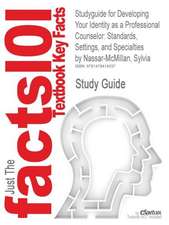Navigating Comprehensive School Change
Autor Robert Everhart, Thomas Chenowethen Limba Engleză Hardback – 21 aug 2017
Preț: 625.03 lei
Preț vechi: 839.00 lei
-26% Nou
Puncte Express: 938
Preț estimativ în valută:
119.62€ • 124.55$ • 101.09£
119.62€ • 124.55$ • 101.09£
Carte tipărită la comandă
Livrare economică 10-24 martie
Preluare comenzi: 021 569.72.76
Specificații
ISBN-13: 9781138466050
ISBN-10: 1138466050
Pagini: 286
Dimensiuni: 210 x 280 mm
Greutate: 0.45 kg
Ediția:1
Editura: Taylor & Francis
Colecția Routledge
Locul publicării:Oxford, United Kingdom
ISBN-10: 1138466050
Pagini: 286
Dimensiuni: 210 x 280 mm
Greutate: 0.45 kg
Ediția:1
Editura: Taylor & Francis
Colecția Routledge
Locul publicării:Oxford, United Kingdom
Public țintă
Professional Practice & DevelopmentCuprins
Chapter 1 How About a Short Course on Navigation?; Chapter 2 Launching the Ship: How Do We Prepare This Thing to Float?; Chapter 3 Is Everybody on Board?; Chapter 4 Did You Say to Turn Port or Starboard?; Chapter 5 Was this Rock on the Chart?; Chapter 6 How Do You Know When You’ve Arrived?; Chapter 7 Conclusions–and (New) Beginnings; Chapter 8 Doesn’t Somebody Out There Have a Chart?; Chapter 9 Ports of Call in Your Future Navigations;
Notă biografică
Authored by Everhart, Robert; Chenoweth, Thomas
Descriere
Like all natural hazards, flooding is a complex and inherently uncertain phenomenon. Despite advances in developing flood forecasting models and techniques, the uncertainty in forecasts remains unavoidable. This uncertainty needs to be acknowledged, and uncertainty estimation in flood forecasting provides a rational basis for risk-based criteria. This book presents the development and applications of various methods based on probablity and fuzzy set theories for modelling uncertainty in flood forecasting systems. In particular, it presents a methodology for uncertainty assessment using disaggregation of time series inputs in the framework of both the Monte Carlo method and the Fuzzy Extention Principle. It reports an improvement in the First Order Second Moment method, using second degree reconstruction, and derives qualitative scales for the interpretation of qualitative uncertainty. Application is to flood forecasting models for the Klodzko catchment in POland and the Loire River in France. Prospects for the hybrid techniques of uncertainty modelling and probability-possibility transformations are also explored and reported.












